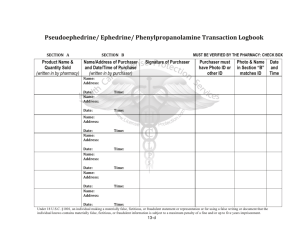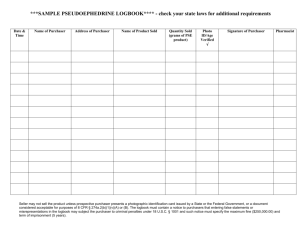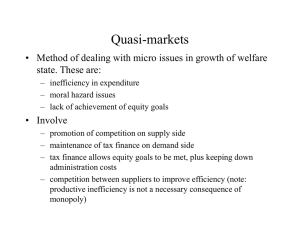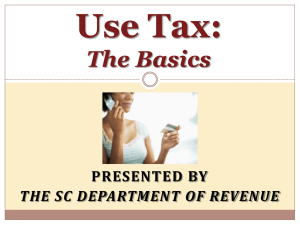A motion by Nebraska and South Dakota to the Governing Board to
advertisement
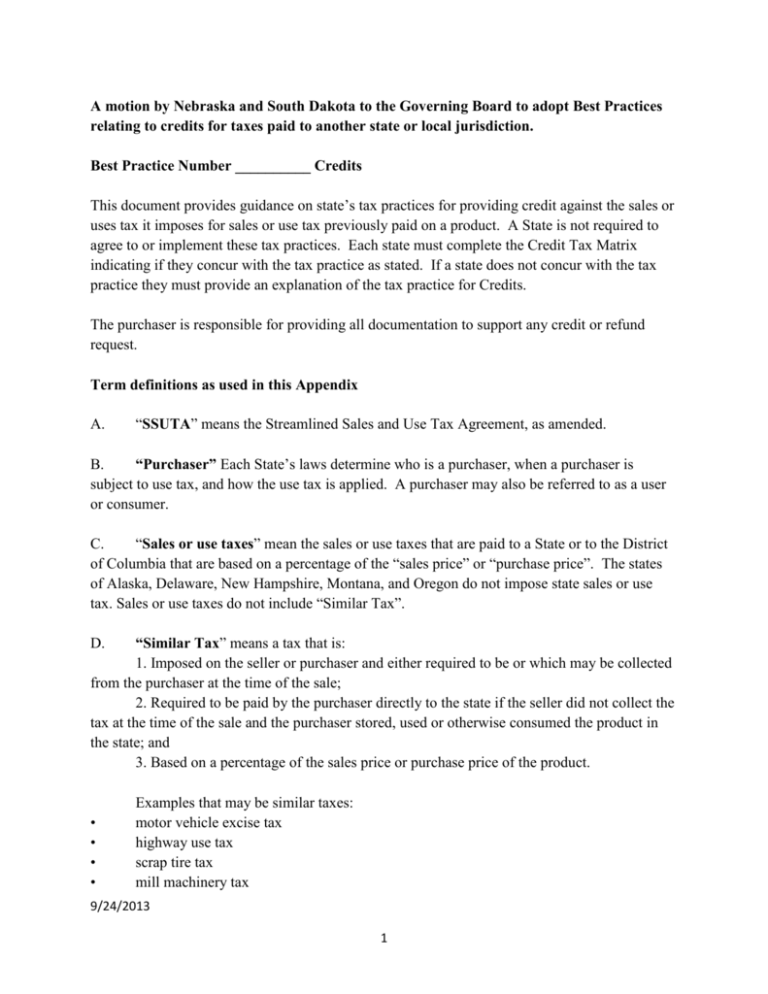
A motion by Nebraska and South Dakota to the Governing Board to adopt Best Practices relating to credits for taxes paid to another state or local jurisdiction. Best Practice Number __________ Credits This document provides guidance on state’s tax practices for providing credit against the sales or uses tax it imposes for sales or use tax previously paid on a product. A State is not required to agree to or implement these tax practices. Each state must complete the Credit Tax Matrix indicating if they concur with the tax practice as stated. If a state does not concur with the tax practice they must provide an explanation of the tax practice for Credits. The purchaser is responsible for providing all documentation to support any credit or refund request. Term definitions as used in this Appendix A. “SSUTA” means the Streamlined Sales and Use Tax Agreement, as amended. B. “Purchaser” Each State’s laws determine who is a purchaser, when a purchaser is subject to use tax, and how the use tax is applied. A purchaser may also be referred to as a user or consumer. C. “Sales or use taxes” mean the sales or use taxes that are paid to a State or to the District of Columbia that are based on a percentage of the “sales price” or “purchase price”. The states of Alaska, Delaware, New Hampshire, Montana, and Oregon do not impose state sales or use tax. Sales or use taxes do not include “Similar Tax”. “Similar Tax” means a tax that is: 1. Imposed on the seller or purchaser and either required to be or which may be collected from the purchaser at the time of the sale; 2. Required to be paid by the purchaser directly to the state if the seller did not collect the tax at the time of the sale and the purchaser stored, used or otherwise consumed the product in the state; and 3. Based on a percentage of the sales price or purchase price of the product. D. • • • • Examples that may be similar taxes: motor vehicle excise tax highway use tax scrap tire tax mill machinery tax 9/24/2013 1 • • • datacenter tax manufacturing tax farm and irrigation equipment excise tax E. “Tax paid” means the sales or use tax paid to a state by either the seller or the purchaser when the purchase of that product is taxable in that state and the sale was properly sourced based on the state’s sourcing rules. Tax paid includes the tax paid by the purchaser directly to a subsequent state because the purchaser moved the property to a different state. Tax paid excludes the portion of tax eligible for a credit or refund. A state may include in the tax paid, the tax paid by the purchaser directly to a subsequent state because the purchaser moved the property to a subsequent state. A state that includes tax paid to a subsequent state must indicate so on the Credit Tax Matrix. Example of Tax Paid to Subsequent State: • Purchaser receives taxable product in State A for $1000 and pays 5% state sales tax of $50. • Purchaser takes product to State B where the state use tax rate is 6%. State B provides credit for sales or use tax paid on the initial purchase. Purchaser pays State B $10 sales or use tax. • Purchaser then takes product to State C where the state use tax rate is 7%. State C provides credit for sales or use tax paid on the initial purchase and for sales or use tax paid for use in a subsequent state. Purchaser pays State C $10 sales or use tax. Example of Tax Paid Eligible for Refund: A purchaser buys a digital product but does not provide seller with a delivery address. The retailer collects 5% sales tax based on the purchaser’s billing address in State A. The purchaser downloads the product in State B, where the sales tax rate is 7%. State A provides refunds directly to purchasers if it is documented the product was not taxable to their state – e.g., no delivery in State A. The purchaser obtains a refund of the 5% sales tax from State A. The purchaser owes State B 7% sales or use tax. Terms defined in A through E apply to the remaining Best Practices. For all Best Practices, the credit provided by a state will not exceed the total state and/or local tax due on a product in that state. 9/24/2013 2 Best Practice 1. State and Local Taxes The state provides credit against the state and local sales or use taxes imposed on a purchaser for state and local sales or use taxes paid to another state or local jurisdiction, regardless of whether the other state provides a reciprocal credit. State may explain in the Comments section of the Matrix whether credit is applied first to the state tax due, with remaining credit applying to any local tax due; or whether credit is prorated between the state and local sales or use tax due. The credit for state and local sales or use taxes imposed on a purchaser may be limited by the criteria in Practices 1.a through 1.f. Best Practice 1.a. Similar Taxes Paid The state provides credit against the state sales or use taxes it imposes on a purchaser for similar taxes paid to another state or local jurisdiction. Best Practice 1.b. Similar Taxes Imposed The state provides credit against similar taxes imposed on a purchaser for sales and use tax paid to another state or local jurisdiction. A state that provides credit against specific similar taxes, but not all, should identify the similar taxes they provide credit against in the comments section of the Matrix. Best Practice1.c. Sourcing at Time of Initial Sale The state provides credit against the sales or use taxes it imposes on a purchaser for sales or use taxes paid to another state or local jurisdiction pursuant to the SSUTA Section 310.A.3, 310.A.4, or 310.A.5. Example A purchaser buys a digital product but does not provide seller with a delivery address. The retailer collects 5% sales tax based on the purchaser’s billing address in State A. The purchaser downloads the product at in State B, where the sales tax rate is 7%. State A provides refunds directly to purchasers if it is documented the product was not taxable to their state - e.g., no delivery in State A. The purchaser can obtain a refund of the 5% sales tax from State A. The purchaser owes State B 7% sales or use tax. 9/24/2013 3 Since the 5% paid to State A is eligible for refund, it is excluded from the definition of “Tax Paid”. Example Same facts as above, except State A could not refund the 5% tax to the purchaser. State B would allow credit for the 5% sales tax paid against the 7% use tax due. The purchaser would pay State B 2% use tax on the purchase. Best Practice 1.d. Characterization of Sale as Product or Service The state provides credit against the sales or use taxes it imposes on a purchaser for sales or use taxes paid to another state or local jurisdiction regardless of the characterization of the sale as a sale of tangible personal property, a service, or other (i.e., digital good). Best Practice 1.e. Sales Price Components The state provides credit against the sales or use taxes imposed on a purchaser for sales or use taxes paid to another state or local jurisdiction on all components of the SSUTA “Sale Price” definition. Example State A includes delivery charges in its definition of “Sales Price”. State B does not include delivery charges in its definition of sales price. A sale of a taxable product is sourced to State A where the tax rate is 5%. The sales price of the product is $11,000, which includes $1,000 for delivery. The purchaser pays $550 sales tax to State A ($11,000 X 5%). The purchaser takes the property to State B where the tax rate is 7%. State B provides full credit for $550 sales tax paid to State A. The purchaser pays an additional $150 use tax to State B. (($10,000 X 7%) - $550). Best Practice 1.f. Transactions with Taxable and Exempt Products The state provides credit against the sale or use taxes imposed on a purchaser for the full amount of sales or use tax paid to another state or local jurisdiction on a transaction consisting of taxable and exempt products. Example A purchaser has a piece of equipment repaired in State A which imposes a 4% sales tax on repair parts and repair labor. The purchaser takes the equipment to State B where repair parts are taxed 9/24/2013 4 at the rate of 7% but repair labor is not taxed. The sale includes $500 for parts and $1000 for labor. The repair shop in State A charges the purchaser $60 sales tax on the $1,500 total charge for parts and labor (4% X $1,500). The purchaser takes the property to State B and uses it in a taxable manner. The tax due in State B on the repair parts is $35 (7% X $500). State B gives credit for the total tax paid to State A ($60) resulting in no additional tax being due in State B. Best Practice 2. Audit Sampling The state provides credit against the sales or use taxes it imposes on a purchaser for sales or use taxes paid to another state or local jurisdiction when the product was part of the population sampled pursuant to an audit sampling method. Best Practice 3. Direct Mail The state provides credit for sales or use taxes paid to another state on advertising and promotional materials pursuant to SSUTA Section 313.A.4. Best Practice 4. Accelerated Payments on Lease/Rentals For sales or use tax paid to another state or local jurisdiction on a lease/rental transaction based on the sum of the lease payments (“accelerated basis”), the state allows a credit against the sales or use tax due on the balance of the lease/rental payments. Example A purchaser enters into a leasing agreement in State A where the state tax rate is 5%. The agreement is for a three-year period with monthly lease payments of $1,000. State A imposes sales tax on an accelerated basis; collecting $1,800 in sales tax at the inception of the lease ($36,000 X 5%). The property remains in State A for 12 months. In month 13, the purchaser moves the property to State B where the state tax rate is 8.0%. State B also imposes tax on an accelerated basis. The purchaser owes use tax at the rate of 8.0% on the remaining 24 lease payments or $1,920. State B allows credit for the $1,800 paid to State A. The purchaser owes an additional $120 to State B ($1,920 - $1,800). Example The same facts as above except that State B imposes tax on the stream of lease payment each month. When the property is moved to State B in month 13, State B begins imposing tax on each payment or $80 per month. 9/24/2013 5 State B allows credit against the use tax due on the monthly payments until such time as the credit is exhausted; any remaining lease payments are subject to tax at the 8% rate. Best Practice 5. Inception-Deferred Collection on Lease/Rentals For sales or use tax imposed by, and paid to, another state or local jurisdiction on a lease/rental transaction based on a deferred collection/remittance method, the state allows a full credit against the sales or use tax due on the balance of the lease/rental payments. Example A purchaser enters into a leasing agreement in State A where the state tax rate is 5%. The agreement is for a three-year period with monthly lease payments of $1,000. State A imposes sales tax at the inception of the lease but allows for deferred collection of the tax. The property remains in State A for 12 months; then is moved to State B where the tax rate is 8%. State A collects tax during the life of the lease. In month 13, the purchaser moves the property to State B where the state tax rate is 8.0%. State A continues to impose its 5% tax on the lease. The lease payments which become due once the property is moved are subject to an additional 3% tax. Best Practice 6. Lessor Acquisition For sales or use tax paid by the lessor to another state or local jurisdiction on the acquisition of the property, the state allows credit against the sales or use tax due on the balance of the lease payments provided the tax reimbursement is documented and disclosed to the lessee. Example A lessor purchases a piece of equipment in State A which will be leased to third parties. The tax rate in State A is 6%. State A allows the lessor to pay tax on its purchase price, $15,000, in lieu of collecting tax on the lease payments. The lessor pays $900 sales tax to state A ($15,000 X 6%). The equipment is leased to a company for three years and the amount of tax paid is disclosed to the lessee. The lessee moves the equipment to State B which has a 7% state tax rate. State B would provide credit of $25 ($900/36) each month against the use tax due in State B. 9/24/2013 6 9/24/2013 7
